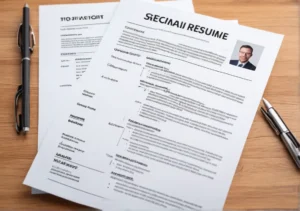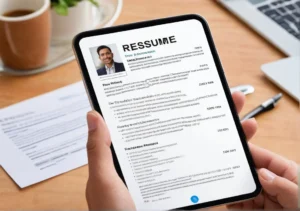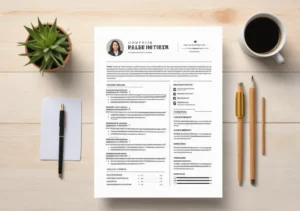Sending out resumes and not getting a bite? It’s a story too many job seekers know all too well. In this post, you’re going to discover how to make your resume not just seen, but irresistible to employers.
Quick Takeaways:
- Tailor your summary and skills section by mirroring the job description’s language to beat ATS and catch hiring managers’ attention.
- Highlight relevant experiences first, and quantify achievements with tangible metrics to showcase your impact.
- Ensure your resume is mobile-friendly with short paragraphs and bulleted lists for streamlined, on-the-go readability.
1. Understand Your Target Role
Starting your job search can sometimes feel like preparing for a journey without a map. Before you even begin tailoring your resume, it’s crucial to have a crystal-clear understanding of the role you’re eyeing. This means going beyond a cursory glance at the job description. Dive deep. Break down what the employer is really looking for in a candidate. What skills are non-negotiable? Is there a particular work ethic highlighted? Essentially, you’re playing matchmaker between your qualifications and their needs.
Here’s a pro tip: Create a side-by-side list. On one side, note down the key responsibilities and skills the job requires. On the other, match those with your own experiences and strengths. This ensures you’re not just throwing everything at the wall to see what sticks, but making targeted efforts to showcase why you’re the perfect fit.
2. Tailor Your Summary Statement
Your summary statement is your elevator pitch. It’s the hook that can catch an employer’s attention or be skimmed over. To make it compelling, it has to resonate with the specific job you’re applying for. Start by pinpointing the essence of what makes you a standout candidate for this role. Are you a seasoned project manager renowned for delivering projects on time and under budget? Mention that, but tailor it to reflect the job’s focus. For instance, if the role emphasizes innovation, you might say, “Seasoned project manager who blends traditional methods with innovative solutions to deliver projects.”
Remember, generic won’t get you noticed. Be specific, and most importantly, be relevant. Adjust your pitch according to what the job description emphasizes.
3. Highlight Relevant Experience
Now, let’s talk about the heart of your resume: your experience section. This is where the rubber meets the road. But here’s a curveball – instead of listing your experiences in chronological order, consider rearranging them to spotlight the most relevant ones first. This isn’t a standard approach, but it’s incredibly effective for roles that require specific experience.
For instance: If you’re applying for a digital marketing role, and you’ve worked on a successful social media campaign, make that the first thing hiring managers see, even if it wasn’t your most recent job. Use bullet points to detail what you did, the skills you used, and the results achieved. Quantify your successes with numbers whenever possible, like “Increased social media engagement by 50% within six months.”
Moreover, don’t be afraid to omit experiences that do not add value to your application for this specific job. Think of your resume as prime real estate; only the most valuable, relevant information deserves a spot.
By following these strategies—understanding your target role, tailoring your summary statement, and highlighting relevant experience—you’re not just applying with a generic resume. You’re presenting a compelling case for why you’re the ideal candidate for the role. Remember, it’s all about making a strong first impression that resonates with the hiring manager.
4. Keywords Are Key
Navigating the maze of the job application process can be daunting, but cracking the code begins with understanding the power of keywords. Every job posting is teeming with specific words or phrases that highlight what the employer is hunting for in an ideal candidate. These are not just fancy buzzwords but are, in reality, the bread and butter of beating the Applicant Tracking Systems (ATS).
To tailor your resume with the right keywords, start by taking a deep dive into the job listing. Look for skills, qualifications, and duties that are emphasized. For instance, if you’re eyeing a position in digital marketing, you might encounter keywords such as “SEO,” “Google Analytics,” or “content creation.” Incorporating these terms into your resume ensures you’re speaking the same language as the hiring manager and the ATS.
Remember, the trick isn’t to randomly sprinkle these words all over your resume but to integrate them seamlessly into your experiences and accomplishments. If the job listing mentions a preference for “team players with excellent communication skills,” find a way to demonstrate how you’ve embodied these traits in your previous roles.
5. Showcase Your Achievements
When it comes to setting yourself apart from the competition, showcasing your achievements is your golden ticket. Employers aren’t just looking for a list of past job responsibilities. They’re on the hunt for proven results that signal you can perform and excel in the role. This is where quantifying your successes comes into play.
Here’s a simple yet impactful strategy: whenever possible, back up your accomplishments with numbers, percentages, or any tangible metrics. Did you increase sales? By what percentage? Did your project management skills lead to a reduction in delivery times? Spell it out.
For instance:
- Before: “Responsible for managing a team and increasing sales.”
- After: “Led a team of 10 and increased sales revenue by 25% within 12 months.”
Such specifics not only add credibility to your claims but also make your achievements more memorable. This approach turns your resume into a compelling narrative of your professional journey, with clear proof of your capabilities.
6. Adjust Your Skills Section
Your ‘Skills’ section offers a unique opportunity to directly align your resume with the job you’re applying for. While it’s tempting to list every skill you possess, customization is key to making a powerful impact.
-
Scan the Job Listing: Start by identifying the hard and soft skills mentioned in the job description. Hard skills might include specific software proficiencies, while soft skills could encompass things like “effective communication” or “problem-solving.”
-
Prioritize Relevant Skills: Choose skills from your repertoire that match the job requirements. If you’re applying for a graphic design position and the listing emphasizes proficiency in Adobe Creative Suite, that skill should be front and center on your resume.
-
Offer Proof: To take it a step further, don’t just list the skills—demonstrate them. Briefly mention how you’ve applied each skill in a professional setting. This not only validates your expertise but also gives the hiring manager a glimpse into how you can contribute to their team.
Here’s a pro tip that can truly set your resume apart: for hard skills, especially those related to technology or specific tools, mention your level of proficiency. For example, instead of simply listing “Python,” say “Python (Intermediate; 2+ years of experience in data analysis projects).” This extra detail can significantly enhance your candidacy by providing clear context.
In summary, customizing your resume might require a bit more effort, but it’s an investment that pays dividends in your job search. By weaving in crucial keywords, showcasing measurable achievements, and adjusting your skills section to mirror the job listing, you’re not just submitting a resume—you’re making a compelling case for why you’re the perfect fit for the role. This tailored approach ensures your application resonates with both ATS and hiring managers, ultimately increasing your chances of landing that dream job.
7. Keep it Fresh
Imagine walking into an orchard, picking the ripest, most succulent fruit off the tree. That feeling of freshness is exactly what hiring managers are looking for when they glance at your resume – a document so tailored and vibrant, it might as well have been picked right off the job description tree. But how do you ensure your resume is as fresh as the morning dew? Let’s dive in.
Always Tailor Your Resume
The cardinal rule of resume customization is to tailor your document to each specific job application. It’s like altering a suit; the better it fits, the more impressive you look. Here’s how to ensure that made-to-measure fit:
- Identify Keywords: Job descriptions are sprinkled with keywords related to skills, experiences, and qualifications. Mirror these phrases in your resume to bypass applicant tracking systems (ATS) and catch the eye of the hiring manager.
- Showcase Relevant Experiences: Highlight your past roles and projects that closely align with the job you’re applying for. This isn’t about rewriting history, but about shining a spotlight on the most pertinent facts.
Leverage Freshness in Examples
Let’s break down two real-world scenarios that illustrate the power of freshness in your resume:
-
The Career Changer : Suppose you’re transitioning from a marketing role to a user experience (UX) design position. Instead of emphasizing your ability to manage social media campaigns, your resume could highlight how you’ve used customer feedback to inform the design of marketing materials, drawing a direct line from marketing skills to user-centered design principles.
-
The Industry Hopper : Imagine you’re moving from the hospitality sector to the tech industry. Rather than focusing on your hotel management experience, you could tailor your resume to showcase your expertise in managing teams, optimizing processes, and improving customer satisfaction – all transferable skills beloved in tech.
The Unexplored Avenue of Freshness
Now, for the unique piece of advice that’s often overlooked: Quantify Your Freshness. Sure, it’s common to use numbers in resumes, but here’s the twist – quantifying how quickly and effectively you can adapt and learn. For instance:
- Adaptability Metric: If you learned a new software or skillset to complete a project ahead of schedule, specify it. Something like, “Learned Adobe XD in two weeks to deliver a client’s website makeover, resulting in a 30% increase in client satisfaction.”
This approach shows not just what you’ve achieved but also how adaptable and quick-learning you are – a trait that’s golden in today’s ever-evolving job market.
Keep It Streamlined for the Mobile User
In our digital age, your resume might be viewed more on a screen smaller than a slice of bread rather than printed out. Here’s a quick checklist to ensure your resume is mobile-friendly:
- Short Paragraphs: Keep them under three lines. This makes it easier for the reader to digest the information.
- Bulleted Lists: Use them for achievements and skills to break up the text.
- Appropriate Fonts: Stick to standard, professional fonts like Arial, Calibri, or Times New Roman. A font size of 11 or 12 should ensure readability on most devices.
By blending the traditional with the innovative, your resume will not only pass the freshness test but also stand out in a crowded orchard of applicants. Remember, every job application is a new opportunity to recalibrate, refine, and refresh your resume. With these strategies, you’ll ensure that your resume is not just a document, but a vivid story of your professional journey tailored to each new adventure.






